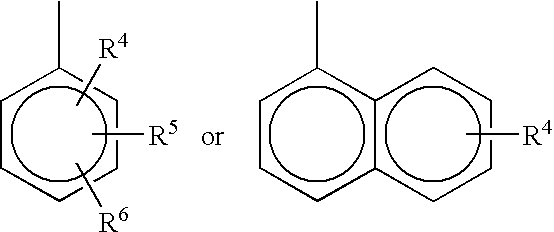Light-sensitive lithographic printing plate
a technology of lithographic printing plate and light-sensitive lithography, which is applied in the direction of lithography, photosensitive materials, instruments, etc., can solve the problems of insufficient processability of the foregoing conventional techniques, and achieve excellent printing durability and high developing latitud
- Summary
- Abstract
- Description
- Claims
- Application Information
AI Technical Summary
Benefits of technology
Problems solved by technology
Method used
Image
Examples
preparation example 1
[0120] Mowiol (registered trade mark) 3-98 polyvinyl alcohol (98% hydrolyzed polyvinyl acetate having an average molecular weight of 16000; 110 g) was added to a closed reaction container equipped with a water-cooled condenser, a dropping funnel and a thermometer to which 250 g of desalted water had been introduced. The mixture was heated at 90° C. for one hour with continuous stirring to thus give a transparent solution. Then the temperature of the solution was adjusted to 60° C. and 3 g of concentrated sulfuric acid was added to the solution. To the solution, there was dropwise added a solution of 4-hydroxybenzaldehyde (59.8 g) and 2,6-di-t-butyl-4-methylphenol (1.4 g) in 450 g of 2-methoxyethanol over 15 minutes. The reaction mixture was diluted with 500 g of additional 2-methoxyethanol and a solution of n-butyl aldehyde (35.3 g) in 500 g of 2-methoxyethanol was dropwise added to the solution. After the complete addition of the aldehyde, the reaction...
preparation example 2
[0122] Airvol (registered trade mark) 502 polyvinyl alcohol (88% hydrolyzed polyvinyl acetate having an average molecular weight of 16000; 110 g) was added to a closed reaction container equipped with a water-cooled condenser, a dropping funnel and a thermometer to which 110 g of desalted water and 110 g of methanol had been introduced. The mixture was heated at 90° C. for one hour with continuous stirring to thus give a transparent solution. Then the temperature of the solution was adjusted to 60° C. and 3 g of concentrated sulfuric acid in 100 g of PM (1-methoxy-2-propanol; Dowanol (registered trade mark)PM) was added to the solution. To the resulting solution, there was dropwise added a solution of 3-hydroxybenzaldehyde (61 g) and 2,6-di-t-butyl-4-methylphenol (1.4 g) in 450 g of PM over 15 minutes. The reaction mixture was diluted with 200 g of additional PM and a solution of n-butyl aldehyde (18.2 g) and propargyl aldehyde (8.1 g) in 500 g of PM wa...
preparation example 3
[0124] Airvol (registered trade mark) 203 polyvinyl alcohol (88% hydrolyzed polyvinyl acetate having an average molecular weight of 18000; 110 g) was added to a closed reaction container equipped with a water-cooled condenser, a dropping funnel and a thermometer to which 110 g of desalted water and 110 g of methanol had been introduced. The mixture was heated at 80° C. for one hour with continuous stirring to thus give a transparent solution. Then the temperature of the solution was adjusted to 60° C. and 3 g of concentrated sulfuric acid in 100 g of PM was added to the solution. To the resulting solution, there was dropwise added a solution of 4-hydroxybenzaldehyde (32 g), 2-hydroxy-1-naphthaldehyde (30 g) and 2,6-di-t-butyl-4-methylphenol (1.4 g) in 500 g of PM over 15 minutes. The reaction mixture was diluted with 200 g of additional PM and a solution of n-butyl aldehyde (21.4 g) in 500 g of PM was dropwise added to the solution. After the complete a...
PUM
| Property | Measurement | Unit |
|---|---|---|
| particle size | aaaaa | aaaaa |
| particle size | aaaaa | aaaaa |
| particle size | aaaaa | aaaaa |
Abstract
Description
Claims
Application Information
 Login to View More
Login to View More - R&D
- Intellectual Property
- Life Sciences
- Materials
- Tech Scout
- Unparalleled Data Quality
- Higher Quality Content
- 60% Fewer Hallucinations
Browse by: Latest US Patents, China's latest patents, Technical Efficacy Thesaurus, Application Domain, Technology Topic, Popular Technical Reports.
© 2025 PatSnap. All rights reserved.Legal|Privacy policy|Modern Slavery Act Transparency Statement|Sitemap|About US| Contact US: help@patsnap.com



